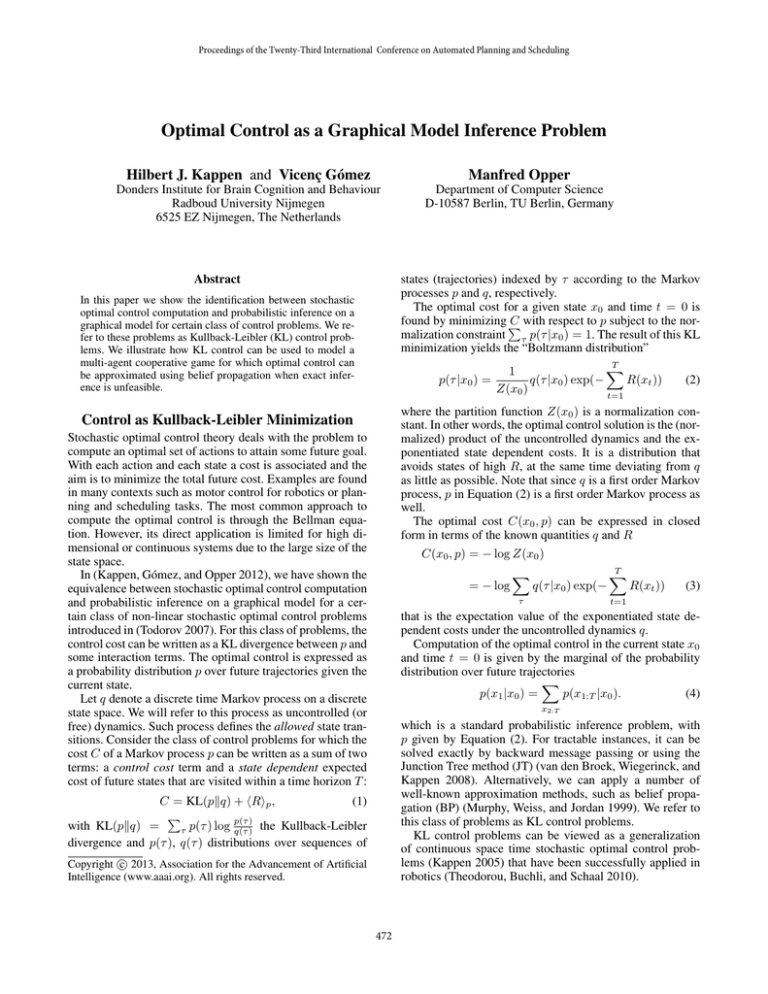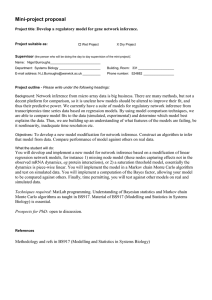
Proceedings of the Twenty-Third International Conference on Automated Planning and Scheduling
Optimal Control as a Graphical Model Inference Problem
Hilbert J. Kappen and Vicenç Gómez
Manfred Opper
Donders Institute for Brain Cognition and Behaviour
Radboud University Nijmegen
6525 EZ Nijmegen, The Netherlands
Department of Computer Science
D-10587 Berlin, TU Berlin, Germany
states (trajectories) indexed by τ according to the Markov
processes p and q, respectively.
The optimal cost for a given state x0 and time t = 0 is
found by minimizing P
C with respect to p subject to the normalization constraint τ p(τ |x0 ) = 1. The result of this KL
minimization yields the “Boltzmann distribution”
Abstract
In this paper we show the identification between stochastic
optimal control computation and probabilistic inference on a
graphical model for certain class of control problems. We refer to these problems as Kullback-Leibler (KL) control problems. We illustrate how KL control can be used to model a
multi-agent cooperative game for which optimal control can
be approximated using belief propagation when exact inference is unfeasible.
p(τ |x0 ) =
T
X
1
q(τ |x0 ) exp(−
R(xt ))
Z(x0 )
t=1
(2)
where the partition function Z(x0 ) is a normalization constant. In other words, the optimal control solution is the (normalized) product of the uncontrolled dynamics and the exponentiated state dependent costs. It is a distribution that
avoids states of high R, at the same time deviating from q
as little as possible. Note that since q is a first order Markov
process, p in Equation (2) is a first order Markov process as
well.
The optimal cost C(x0 , p) can be expressed in closed
form in terms of the known quantities q and R
Control as Kullback-Leibler Minimization
Stochastic optimal control theory deals with the problem to
compute an optimal set of actions to attain some future goal.
With each action and each state a cost is associated and the
aim is to minimize the total future cost. Examples are found
in many contexts such as motor control for robotics or planning and scheduling tasks. The most common approach to
compute the optimal control is through the Bellman equation. However, its direct application is limited for high dimensional or continuous systems due to the large size of the
state space.
In (Kappen, Gómez, and Opper 2012), we have shown the
equivalence between stochastic optimal control computation
and probabilistic inference on a graphical model for a certain class of non-linear stochastic optimal control problems
introduced in (Todorov 2007). For this class of problems, the
control cost can be written as a KL divergence between p and
some interaction terms. The optimal control is expressed as
a probability distribution p over future trajectories given the
current state.
Let q denote a discrete time Markov process on a discrete
state space. We will refer to this process as uncontrolled (or
free) dynamics. Such process defines the allowed state transitions. Consider the class of control problems for which the
cost C of a Markov process p can be written as a sum of two
terms: a control cost term and a state dependent expected
cost of future states that are visited within a time horizon T :
C(x0 , p) = − log Z(x0 )
= − log
X
τ
q(τ |x0 ) exp(−
T
X
R(xt ))
(3)
t=1
that is the expectation value of the exponentiated state dependent costs under the uncontrolled dynamics q.
Computation of the optimal control in the current state x0
and time t = 0 is given by the marginal of the probability
distribution over future trajectories
X
p(x1 |x0 ) =
p(x1:T |x0 ).
(4)
x2:T
which is a standard probabilistic inference problem, with
p given by Equation (2). For tractable instances, it can be
solved exactly by backward message passing or using the
Junction Tree method (JT) (van den Broek, Wiegerinck, and
Kappen 2008). Alternatively, we can apply a number of
well-known approximation methods, such as belief propagation (BP) (Murphy, Weiss, and Jordan 1999). We refer to
this class of problems as KL control problems.
KL control problems can be viewed as a generalization
of continuous space time stochastic optimal control problems (Kappen 2005) that have been successfully applied in
robotics (Theodorou, Buchli, and Schaal 2010).
C = KL(pkq) + hRip ,
(1)
P
p(τ )
with KL(pkq) =
τ p(τ ) log q(τ ) the Kullback-Leibler
divergence and p(τ ), q(τ ) distributions over sequences of
c 2013, Association for the Advancement of Artificial
Copyright Intelligence (www.aaai.org). All rights reserved.
472
Example: Multi-Agent Cooperative Game
λ = 10
We illustrate the KL control using a variant of the stag hunt
game, a prototype game of social conflict between personal
risk and mutual benefit (Skyrms 2004). The original game
consists of two hunters that can either hunt a hare by themselves giving a small reward, or cooperate to hunt a stag and
getting a bigger reward, see table 1. Both stag hunting (payoff equilibrium, top-left) and hare hunting (risk-dominant
equilibrium, bottom-right) are Nash equilibria.
Stag
Hare
Stag
3, 3
1, 0
Hare
0, 1
1, 1
λ = 0.1
20
20
15
15
10
10
5
5
1
1
1
5
10
15
20
1
5
10
15
20
Figure 2: Approximate inference KL-stag-hunt using BP in a large
grid for M = 10 hunters. Hares and stags are denoted using small
and big diamonds respectively. Initial and final positions of the
hunters are denoted using small circles and asterisks respectively.
T = 10 time-steps. The trajectories obtained from BP are drawn
in continuous lines. (Left) Risk dominant control is obtained for
λ = 10, where all hunters go for a hare. (Right) Payoff dominant
control is obtained for λ = 0.1. In this case, all hunters cooperate
to capture the stags except the ones on the upper-right corner, who
are too far away from the stag to reach it in ten steps.
Table 1: Payoff matrix for the two player stag-hung game.
We define the KL-stag-hunt game as a multi-agent version
of the original stag hunt game where M agents live in a 2D
grid of N locations and can move to adjacent locations. The
grid also contains hares and stags at certain fixed locations.
The game is played for a finite time T and at each time-step
all the agents can move.
We formulate the problem as a KL control problem. The
uncontrolled dynamics factorizes among the agents. It allows an agent to stay on the current position or move to an
adjacent position (if possible) with equal probability, thus
performing a random walk on the grid. The state dependent
cost R(xT )/λ defines the profit when at the end time T , two
(or more) agents are at the location of a stag, or individual
agents are at a hare location (Kappen, Gómez, and Opper
2012). Figure 1 shows the associated graphical model.
exp − λ1 R
x11
ψq
x12
ψq
x1T −1
ψq
x1T
x21
ψq
x22
ψq
x2T −1
ψq
x2T
ψq
xM
2
ψR
Figure 2 shows results obtained using BP for λ = 10
and λ = 0.1. Trajectories are random realizations calculated
from the BP estimated marginals at factor nodes. For high
λ, each hunter catches a hare. In this case, the cost function
is dominated by the KL term. For sufficiently small λ, the
R(xT )/λ term dominates and hunters cooperate and organize in pairs to catch stags. Thus λ can be seen as a parameter that determines whether the optimal control strategy is
risk-dominant or payoff-dominant.
This example shows how KL control can be used to
model a complex multi-agent cooperative game. The graphical model representation of the problem allows to use approximate inference methods like BP that provide an efficient and good approximation of the control for large systems where exact inference is not feasible.
References
xM
1
ψq
xM
T −1
ψq
Kappen, H. J.; Gómez, V.; and Opper, M. 2012. Optimal control as
a graphical model inference problem. Mach. Learn. 87:159–182.
Kappen, H. J. 2005. Linear theory for control of nonlinear stochastic systems. Phys. Rev. Lett. 95(20):200201.
Murphy, K.; Weiss, Y.; and Jordan, M. 1999. Loopy belief propagation for approximate inference: An empirical study. In UAI’99,
467–47. San Francisco, CA: Morgan Kaufmann.
Skyrms, B., ed. 2004. The Stag Hunt and Evolution of Social
Structure. Cambridge, MA, USA: Cambridge University Press.
Theodorou, E. A.; Buchli, J.; and Schaal, S. 2010. Reinforcement learning of motor skills in high dimensions: A path integral
approach. In ICRA 2010, 2397–2403. IEEE Press.
Todorov, E. 2007. Linearly-solvable markov decision problems. In
NIPS 19. Cambridge, MA: MIT Press. 1369–1376.
van den Broek, B.; Wiegerinck, W.; and Kappen, H. J. 2008.
Graphical model inference in optimal control of stochastic multiagent systems. J. Artif. Int. Res. 32(1):95–122.
xM
T
Figure 1: Factor graph representation of the KL-stag-hunt
problem. Circles denote variables (states of the agents at a
given time-step) and squares denote factors. There are two
types of factors: the ones corresponding to the uncontrolled
dynamics ψq and one corresponding to the state cost ψR that
couples all agents states. Initial configuration in gray denotes
the agents “clamped” to their initial positions.
Computing the exact solution using the JT method becomes unfeasible even for small number of agents, since
the joint state space scales as N M . Belief propagation (BP)
algorithm is an alternative approximate algorithm that has
polynomial time and space complexity an can be run on an
extended factor graph where the factor ψR is decomposed.
473








